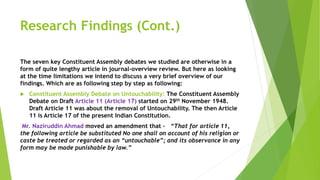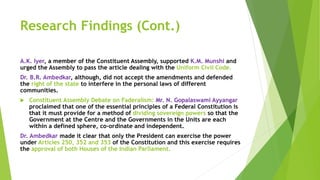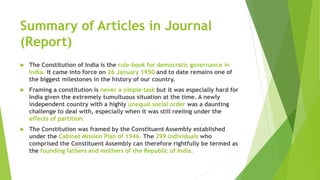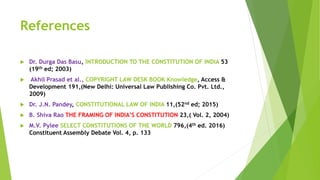Debates In Constituent Assembly: Seven Key Debates in India Constituent Assembly
- 1. Debates in Constituent Assembly Seven key Debates in Constituent Assembly
- 2. Debates in Constitution Assembly Name: Gurjant Singh Courses: BSc. Botany (Hons) Elective Course: Introduction to Indian Constitution Enrollment no. : 1831302013 Shoolini University of Biotechnology and Management Sciences
- 3. Topics to be discussed: Introduction Significance of our Article in Journal (Project Work) Why Constituent Assembly debates matter Research Approaches (Methodology) Facts related to the Constituent Assembly debates Research Findings (Report) Statistical Research Findings (Report) Summary References
- 4. Introduction Constituent Assembly Debates refer to the debates and discussions that the Constituent Assembly members had in the process of drafting a constitution for free India. The Constituent Assembly sat for the first time on 9th December 1946. Over the next 2 years and 11 months, the Assembly sat for a total of 165 days to frame the Indian Constitution. The final session of the Constituent Assembly took place on 24th January 1950.
- 5. Significance of our Article in Journal (project work) It will help you out to intelligible the very basics of seven key Debates in Constituent Assembly used to happened in 20th century in India. Our project work do emphasis on the repercussions of the key Debates in Constituent Assembly. It will also take you back into the history how our Constitution framers used to cast the world’s longest Constitution. Our project work will do introduce you with the quantitative, qualitative, and analytical finding of Constituent Assembly Debates. This project will inculcate you key amendments took place at that time too. Our project work will also make you familiar with the overall essence or report of our keen studies on Constituent Assembly debates.
- 6. Why Constituent Assembly debates matter That debates of the constituent assembly were held to discuss the rationale behind each of the clause of the draft constitution that was made under the guidance of Dr. B.R. Ambedkar these debates helped in making amendment in the clauses of the draft constitution with the help of these debates more than 2000 amendments were made in the draft constitution.
- 7. Research approaches (Methodology) Key research methodologies being utilized during the overall findings of our article in journal of Constituent Assembly debates were as following: Previous Review Papers: Review papers of various authors were being used for references. Qualitative Data: Quality of the material was also put under the very main concern for the project work. Quantitative Data: Little Quantitative data was also employed for better understanding. Statistical Analysis: Statistical finding of Constituent Assembly debates were also presented in our article in journal. Books References: E-books and handbooks were also used for references. Others: Literature revisions, Data evaluation, sorting, Historical Research etc.
- 8. Facts related to the Constituent Assembly Debates The Constituent Assembly spent a total of about 165 days in framing the Constitution. Clause by clause discussion was done for about 101 days where the members discussed the text of the Constitution. About 36 lakh words were spoken in all and Dr. B R Ambedkar had the distinction of having spoken the most number of words. Fundamental rights, included in Part III, was debated for about 16 days, i.e., about 14% of the clause by clause discussion. The Directive Principles of State Policy (included in Part IV) was discussed for about 6 days (about 4%). Altogether, women members contributed to about 2% of the discussions.
- 9. Research Findings (Report) On our overall study of articles in Journal we have divided the Constituent Assembly debates into four major sections: Preliminary stage (9/12/1946 to 27/01/1948): The guiding principles of the Constitution were outlined in reports submitted by certain committees such as the Fundamental Rights and Minorities Committee, Union Powers Committees, etc. Also, the Drafting Committee was formed to draft the Constitution. First reading (4/11/1948 to 9/11/1948): Introduction of the draft constitution in the Assembly. Second reading (15/11/1948 to 17/10/1949): The draft was discussed clause by clause. Third reading (14/11/1949 to 26/11/1949): The third reading of the Constitution was completed and it was enacted on 26th November.
- 10. Statistical Research Findings (Cont.) The Assembly met for a total number of 165 days between 1946 and 1950. 46 days were spent on preliminary discussion in the Assembly and 101 days were spent on the second reading of clause by clause discussion of the draft Constitution. Meanwhile, 5 days were spent on first reading and 13 days on third reading Approximately 36 lakh words were spoken during Assembly debates.
- 11. Research Findings (Cont.) The seven key Constituent Assembly debates we studied are otherwise in a form of quite lengthy article in journal-overview review. But here as looking at the time limitations we intend to discuss a very brief overview of our findings. Which are as following step by step as following: Constituent Assembly Debate on Untouchability: The Constituent Assembly Debate on Draft Article 11 (Article 17) started on 29th November 1948. Draft Article 11 was about the removal of Untouchability. The then Article 11 is Article 17 of the present Indian Constitution. Mr. Naziruddin Ahmad moved an amendment that – “That for article 11, the following article be substituted No one shall on account of his religion or caste be treated or regarded as an “untouchable”; and its observance in any form may be made punishable by law.”
- 12. Research Findings (Cont.) Dr. Mono Mohan Das was of the opinion that the removal of Untouchability is an important fundamental right. Mr. Santanu Kumar Das proposed for the removal of social inequality. Professor K.T. Shah made a suggestion that the definition of Untouchability is nowhere given in the Constitution. Constituent Assembly Debate on Uniform Civil Code: Mohammad Ismail from Madras moved the following provision for addition to Article 33 which provided that ‘any group, section or community of people shall not be obliged to give up its own personal laws. M.A. Ayyangar, a member of the Constituent Assembly, intervened and remarked on it as a matter of contract.
- 13. Research Findings (Cont.) A.K. Iyer, a member of the Constituent Assembly, supported K.M. Munshi and urged the Assembly to pass the article dealing with the Uniform Civil Code. Dr. B.R. Ambedkar, although, did not accept the amendments and defended the right of the state to interfere in the personal laws of different communities. Constituent Assembly Debate on Faderalism: Mr. N. Gopalaswami Ayyangar proclaimed that one of the essential principles of a Federal Constitution is that it must provide for a method of dividing sovereign powers so that the Government at the Centre and the Governments in the Units are each within a defined sphere, co-ordinate and independent. Dr. Ambedkar made it clear that only the President can exercise the power under Articles 250, 352 and 353 of the Constitution and this exercise requires the approval of both Houses of the Indian Parliament.
- 14. Research Findings (Cont.) According to Article 1 of the Constitution, India is a Union of States. As the Chairman of the Drafting Committee, Dr. Ambedkar was responsible for the word UNION being substituted for FEDERATION. Constituent Assembly Debate on Preamble: Prof K T Shah proposed inserting the words, “Secular, Federal, Socialist”. According to Ambedkar, this proposal was rejected because “What should be the policy of the State. Mr. H.V. Kamath also opposed the amendment proposed by Mr. K.T. Shah. Shri Gopi Krishna Vijayavargiya told that Sovereignty is specifically mentioned in the Chinese Constitution as it is an important power. A few members in the Constituent Assembly wanted to include ‘In the name of God’.
- 15. Research Findings (Cont.) Constituent Assembly Debate on Abolition of Death Penalty: Between 1947 and 1949, the Constituent Assembly debated the Death Penalty. The question was asked because of its judge-centric nature, possible uncertainty in its enforcement, its discriminatory impact on the poor and the marginalised sections, and the possibility of error in the final judgment. Mr. Z.H. Lari proposed for the insertion of Article 11-B in which he proposed the abolition of capital punishment except for sedition involving the use of violence. Shri. K. Hanumanthaiya expressed that instead of capital punishment, life imprisonment must be given to the convict.
- 16. Research Findings (Cont.) Constituent Assembly Debate on Right to Equality and Prohibition of Discrimination: Article 14 of the Indian Constitution is – equality before law and Article 15 is – prohibition of discrimination on grounds of religion, race, caste, sex or place of birth. Mr. C. Subramaniam suggested that the State has no power to discriminate in the above-mentioned matters. Mr. Syed Abdur Rouf suggested inserting the words “place of birth” instead of the word “sex”. Prof. K.T. Shah suggested, through an amendment, to use the word “religion” in place of the word “creed”. Sardar Bhopinder Singh Mann suggested that “at the time of deciding about the fundamental rights, it would be incomplete if places of worship are not included in the list of such rights.”
- 17. Summary of Articles in Journal (Report) The Constitution of India is the rule-book for democratic governance in India. It came into force on 26 January 1950 and to date remains one of the biggest milestones in the history of our country. Framing a constitution is never a simple task but it was especially hard for India given the extremely tumultuous situation at the time. A newly independent country with a highly unequal social order was a daunting challenge to deal with, especially when it was still reeling under the effects of partition. The Constitution was framed by the Constituent Assembly established under the Cabinet Mission Plan of 1946. The 299 individuals who comprised the Constituent Assembly can therefore rightfully be termed as the founding fathers and mothers of the Republic of India.
- 18. Summary of Articles in Journal (Report) (Cont.) Certain members of the Constituent Assembly played a key role, the foremost of whom was Dr. B.R. Ambedkar. Other Congress stalwarts like Prime Minister Jawaharlal Nehru, Dr. Rajendra Prasad, and Maulana Azad were also dominant voices in Assembly proceedings. A special mention must go to Constitutional Advisor, Dr. B.N. Rau compiled the initial draft that the assembly debated after taking inputs from constitutional experts at home and abroad. Today, as we have entered the 74th year by 2021 of our independence, our Constitution still stands as a shining beacon of democratic governance. It is because of the members of the constituent assembly that our flag flutters proudly over the Parliament in Delhi.
- 19. References Dr. Durga Das Basu, INTRODUCTION TO THE CONSTITUTION OF INDIA 53 (19th ed; 2003) Akhil Prasad et al., COPYRIGHT LAW DESK BOOK Knowledge, Access & Development 191,(New Delhi: Universal Law Publishing Co. Pvt. Ltd., 2009) Dr. J.N. Pandey, CONSTITUTIONAL LAW OF INDIA 11,(52nd ed; 2015) B. Shiva Rao THE FRAMING OF INDIA’S CONSTITUTION 23,( Vol. 2, 2004) M.V. Pylee SELECT CONSTITUTIONS OF THE WORLD 796,(4th ed. 2016) Constituent Assembly Debate Vol. 4, p. 133
- 20. Thank you!



















